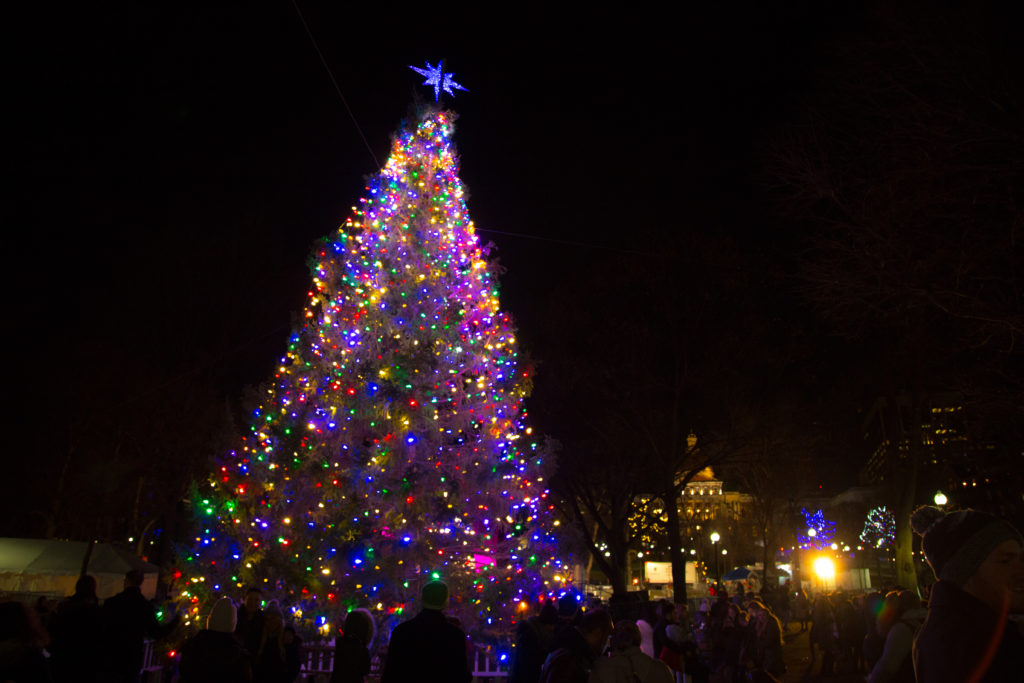Boston and Nova Scotia continue Christmas tree tradition
December 5, 2018
The 46-foot white spruce tree adorned with Christmas lights on Boston Common traveled more than 600 miles to its spot for the season near Park Street station, continuing a decades-long tradition.
The tree, which was set up on Boston Common Nov. 20, came from Halifax, Nova Scotia. It is an annual gift and a sign of gratitude to the city of Boston for the assistance it provided after a major explosion that occurred Dec. 6, 1917, when a Norwegian vessel collided with a French cargo ship that was carrying explosives in a strait that connected the Halifax Harbor to Bedford Basin.
After the explosion, which killed about 2,000 and injured 5,000 others, Massachusetts officials and community members rushed to send help and supplies to Halifax, the capital of Nova Scotia and a city with a population of about 60,000 at the time.
Immediately after word of the tragedy reached Boston, Gov. Samuel McCall wired Halifax asking what the city needed.
“Massachusetts stands ready to go to the limit in rendering every assistance you may be in need of,” his message read, according to The Boston Globe’s archives.
That night, 10 doctors, 20 nurses and a movable hospital supplied by the Volunteer Aid Association hopped on a train and started to head toward Halifax.
“At the first report of the horror, and before any details were known, we at once dispatched a train with our foremost surgeons and trained nurses to carry help,” McCall said at a meeting at Faneuil Hall two days after the explosion. “This vanguard was followed yesterday by another train, and we shall continue to send them as long as they are needed.”
On Dec. 9, 1917, three days after the explosions, a steamship left Boston laden with 25,000 blankets and glass to replace windows in more than 1,000 houses. The shock of the blast instantly destroyed 1,600 houses and damaged 12,000 others, according to a report by the Washington Post. Many windows shattered, sending shards into people’s eyes and blinding 37.
The day after the explosion, the Massachusetts Public Safety Committee called a special meeting to discuss sending help north. The head of the group, Henry Endicott, said that $100,000 had already been raised and that he expected the Commonwealth would be able to raise a total of $1,000,000 for the Halifax relief fund.
Community groups around Massachusetts garnered the support of their members in order to collect money, clothing and other supplies to send to the affected city.
The Massachusetts Woman Suffrage Association collected clothing to send to the victims of the disaster at their Boylston Street location. The Henry Jewett Players put on a special performance of their play “The Man Who Stayed at Home” at the Copley Theatre to raise money for the Halifax victims. Members of the Boston Athletic Association raised more than $2,000 in donations when they passed around a hat after a comedy show.
The city celebrated its 77th annual tree lighting on Boston Common Nov. 29. This year’s tree came from Oxford, Nova Scotia and was donated by Ross McKellar and Teresa Simpson, according to a statement from the city of Boston.
“Our Christmas tree lighting is more than a holiday event, it is a celebration of the lasting bond of friendship between our city and Nova Scotia,” said Mayor Martin J. Walsh in the press release. “Thanks to Ross and Teresa for providing this gift that will be the centerpiece of our holiday lighting display on Boston Common, taking a place of honor as Boston’s official Christmas tree to be enjoyed by residents and visitors alike.”






